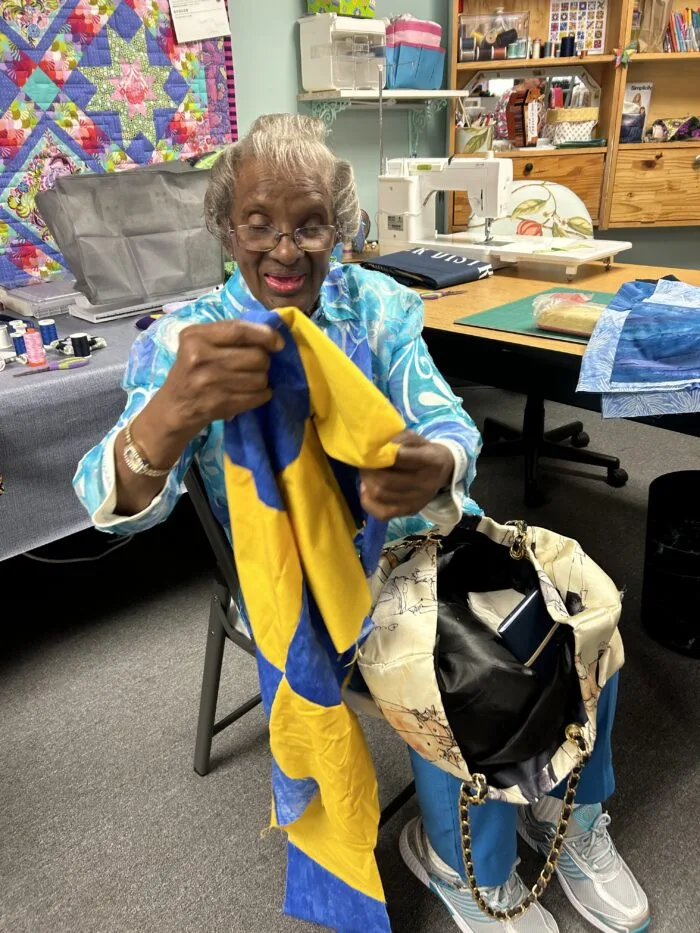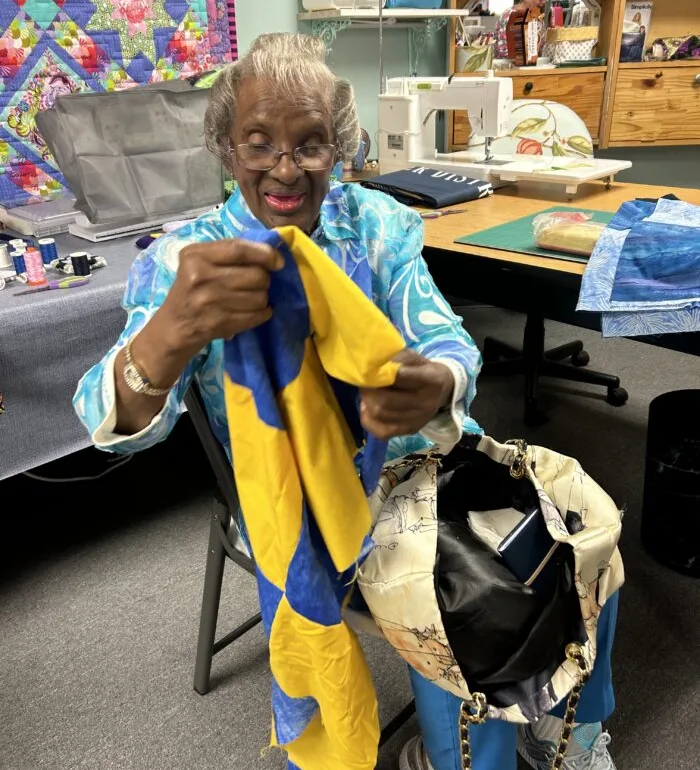This story originally aired in the Nov. 19, 2023 episode of Inside Appalachia.
Quiltmaking is an artform that has been passed down for generations throughout Appalachia. But a few years ago, local community activist Emily Jones Hudson noticed that quilting wasn’t as popular as it once was, particularly in Hazard’s Black community.
“[Quilting] is a big thing in the Appalachian culture. It’s a big thing in the African American culture,” Hudson said. “And one of the things that I was concerned about was that this tradition in the African American community was dying out.”
So in 2022, Hudson set out on a mission to encourage people to quilt again by establishing the Stories Behind the Quilt workshops. The workshops are a project of the Southeast Kentucky African-American Museum and Cultural Center.
Each week for over a month, Hudson and others met at Appalachian Quilt and Yarn in downtown Hazard with the goal of making a quilt together. Many of the participants had never made a quilt on their own, but had grown up with family members who were quilters.
Hudson recalls her mother quilting, but did not have an interest in learning the craft when she was young.
Hudson’s sister, Sandra Jones, took a liking to sewing as a child. Jones had distinct memories of working alongside her mother as she made quilts. “I grew up watching my mom, helping my mom sew and quilt,” Jones said. “I would help her cut, I would help her iron. I would help her do other little things — like markings — so we could get the measurements right.”
Katie Glover, who is in her 80s, is another participant in the workshop. She reflected on some of her earliest experiences watching her mother and grandmother quilt. “I would watch them sit around and watch them make quilts. They would have this old quilting frame that would be hanging from the ceiling,” Glover said. “And now all the neighbors would come and help them sew. And they sewed by hand.”

Credit: Capri Cafaro/West Virginia Public Broadcasting
While all three of these women had early experiences with quilting, it wasn’t something they pursued in their adult life. Most were too busy balancing work and family. And they no longer needed to make quilts just to keep warm.
Having little hands-on experience with quilting did not deter them from working together to make a quilt. Out of everyone in the group, Jones had spent the most time sewing, so she ended up leading the process. While she had never made a quilt, she had made clothes for years.
Still, there was a learning curve for Jones and the others. “When we started these workshops we didn’t really know what we were doing until we [sat] around and started talking about what was important to us,” Jones said. “And it just kind of unfolded.”
Rebecca Cornett, another Hazard-area resident who helped make the group quilt, said it was both exciting and emotional to watch the quilt come together.
“We eventually started cutting the fabric and putting it together,” Cornett said. “And then the reality hit. It was just overwhelming for me to see the completion of a quilt that was in our heads.“
The completed quilt tells a powerful story. The group selected a piece of fabric from Ghana as the focal point of the quilt. It depicts a woman working. The woman is surrounded by fabric in varying shades of green, printed with mountains. Below are outlines of faces in shades of brown floating in a sea of blue. And at the top of the quilt are orange and yellow strips of fabric to create a sunrise.
After days of cutting and sewing together, they created a piece that captured the struggles of the group’s African ancestors, their journey to Appalachia and the promise of a brighter future.
Jones said the quilt symbolizes the connection between Africa and Appalachia. “In the water you see heads floating. These are actually slaves who were thrown overboard. The mountains represent the Appalachian mountains because we’re tying in Africa and Appalachia culture.”
Jones explained the sunrise at the top symbolizes a new dawn for African Americans as they transcend struggle. When the quilt was finally completed, Jones breathed a sigh of relief.
“It was intense from beginning to end. But when I finished, it was like a weight had been lifted off my shoulders.”
The finished quilt wasn’t the only thing to come out of the workshop. During the process, Hudson said they also shared stories of their lives.
“One of the things that happens as we’re sitting around making this quilt is we share history. And we start talking about the history — the local history — of the area,” Hudson said. “One workshop as we were quilting, the topic just came up of Black businesses that used to be here in the area. Another workshop we talked about Black churches.”
It was important to the group to document the stories that emerged.
“If we don’t get the history documented, it’s like with each passing generation, it’s like we never were here,” Hudson said.
The quilting workshops created a sense of community that the group wanted to continue. So they decided to keep making quilts together. They’ve made two quilts and have plans to make one more. Jones noticed the participants’ quilt making confidence grew between the first workshop series and the second.
“Everybody was a little hesitant during the first workshop because they never used a sewing machine. They never quilted or sewn anything. So the second time around, you know, they were more excited about it,” Jones said.
The Stories Behind The Quilt workshops have reinvigorated an interest in quilt making within Hazard’s Black community. Just as Hudson had hoped.
For example, Katie Glover is now a committed quilter. She has made four quilts and has started two more. And she has a specific reason she’s making so many.
“I’m going to give them to my grandbabies,” Glover said.
Cornett thinks that sharing stories about making quilts with her kids is helping spark new interest in the younger generation. Now when Cornett’s children visit her, they ask to come to the quilt shop.
“They want to come down to see what I’m talking about. And so I think this is only the beginning of getting history being talked about, young people being interested. And I just think it’s the beginning of something good,” Cornett said.
As the workshops continue, there will be a chance for new people to join the process. They’ll continue the work started by this group of women, sustaining Hazard’s tradition of quilt making, one stitch at a time.
——
This story is part of the Inside Appalachia Folkways Reporting Project, a partnership with West Virginia Public Broadcasting’s Inside Appalachia and the Folklife Program of the West Virginia Humanities Council.
The Folkways Reporting Project is made possible in part with support from Margaret A. Cargill Philanthropies to the West Virginia Public Broadcasting Foundation. Subscribe to the podcast to hear more stories of Appalachian folklife, arts and culture.



